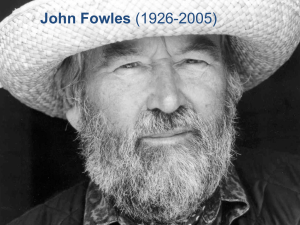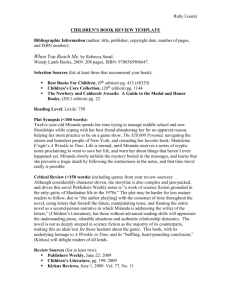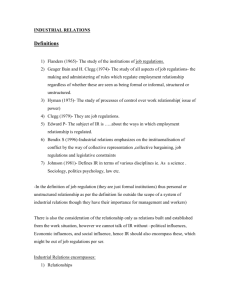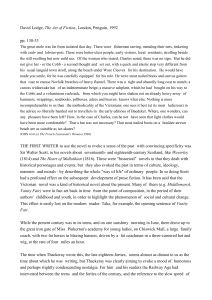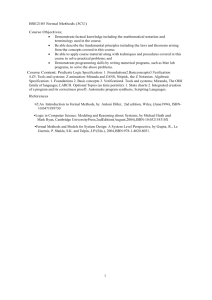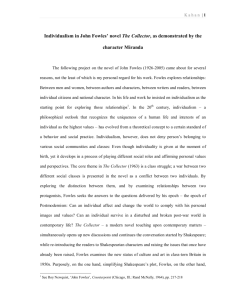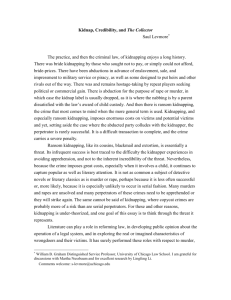Reader`s Response Essay
advertisement
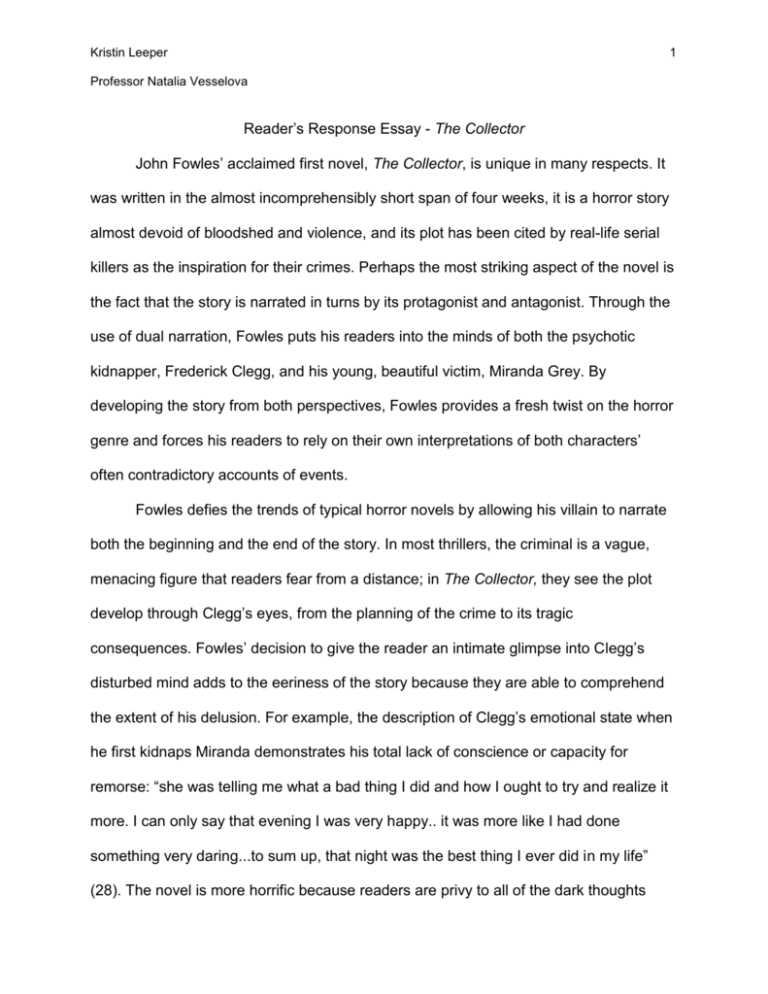
Kristin Leeper 1 Professor Natalia Vesselova Reader’s Response Essay - The Collector John Fowles’ acclaimed first novel, The Collector, is unique in many respects. It was written in the almost incomprehensibly short span of four weeks, it is a horror story almost devoid of bloodshed and violence, and its plot has been cited by real-life serial killers as the inspiration for their crimes. Perhaps the most striking aspect of the novel is the fact that the story is narrated in turns by its protagonist and antagonist. Through the use of dual narration, Fowles puts his readers into the minds of both the psychotic kidnapper, Frederick Clegg, and his young, beautiful victim, Miranda Grey. By developing the story from both perspectives, Fowles provides a fresh twist on the horror genre and forces his readers to rely on their own interpretations of both characters’ often contradictory accounts of events. Fowles defies the trends of typical horror novels by allowing his villain to narrate both the beginning and the end of the story. In most thrillers, the criminal is a vague, menacing figure that readers fear from a distance; in The Collector, they see the plot develop through Clegg’s eyes, from the planning of the crime to its tragic consequences. Fowles’ decision to give the reader an intimate glimpse into Clegg’s disturbed mind adds to the eeriness of the story because they are able to comprehend the extent of his delusion. For example, the description of Clegg’s emotional state when he first kidnaps Miranda demonstrates his total lack of conscience or capacity for remorse: “she was telling me what a bad thing I did and how I ought to try and realize it more. I can only say that evening I was very happy.. it was more like I had done something very daring...to sum up, that night was the best thing I ever did in my life” (28). The novel is more horrific because readers are privy to all of the dark thoughts Kristin Leeper 2 Professor Natalia Vesselova that lurk in the villain’s mind and are all too aware of the potential danger that could ensue if he gives in to them. Since readers are presented with two descriptions of the events in the novel, they are forced to think critically and to form their own conclusions based on each narrator’s account, because neither one is free from bias or is completely reliable. Clegg’s perspective is limited because his vision is clouded by his obsession with Miranda, while hers is tainted by her anger towards him for refusing to release her. Together the two accounts provide the readers with an overall idea of events, but it is up to them to fill in the gaps and to discern the truth from the lies and contradictions. By using this technique, Fowles engages his readers and requires them to read more actively; instead of simply telling the story, he creates a challenging plot that must be carefully interpreted. I encountered Fowles’ technique in the past when I read Guy Vanderhaege’s The Last Crossing in my grade twelve English class; this novel was narrated by no less than seven different characters. While Fowles’ usage of multiple narrators is highly effective, Vanderhaege’s decision to implement this technique was detrimental to the overall story, because his attempt to tell the story from so many different perspectives resulted in a plot that was often complex and convoluted. Rather than enriching the novel, the use of multiple narrators created a lot of potential confusion for the reader; Fowles smartly avoided this problem by keeping his story simple. Vanderhaege’s technique worked best when he was describing the love triangle between three of its characters, Kristin Leeper 3 Professor Natalia Vesselova because it allowed him to demonstrate the miscommunications between them, just as Fowles is able to illustrate the colossal lack of understanding that overshadows Clegg and Miranda’s relationship. For example, the scene in which Miranda attempts to break all of the plates in Clegg’s dining room is described by Clegg in a tone of surprise and indignation, while Miranda’s account of the same scene is underscored with a deep sense of frustration: “I gave him hell tonight...what happens if he has a crash? A stroke. Anything. I die. I couldn’t get out. All I did the day before yesterday was to prove it” (215). Clegg is unable to understand how Miranda’s perpetual imprisonment is making her increasingly desperate and unhappy; instead, he expects her to behave according to social norms, as if she were an invited guest. Fowles smartly limits his comparison to two characters, as opposed to Vanderhaege’s seven, in order to provide an in-depth analysis of their dysfunctional relationship. Fowles’ decision to narrate the story from the perspectives of both the antagonist and the protagonist was the key to the novel’s success. He was able to create an intimate portrayal of his villain without neglecting the character development of the protagonist, and he created an intricate, complex novel while still ensuring that his readers were able to comprehend the overall plot. If Fowles had chosen to narrate the novel from simply one character’s perspective - either Miranda’s or Clegg’s - it would have been far less insightful and effective. Clegg’s evident mental unbalance makes his section of the novel chilling and fascinating to read, but also leaves him incredibly Kristin Leeper 4 Professor Natalia Vesselova limited in terms of a narrator; it is necessary to have Miranda’s portion of the novel in order to fill in the gaps. Likewise, if Clegg’s portion was omitted, the story would lose a great deal of its effectiveness as a psychological thriller, because the reader would not be able to examine his demented thoughts. In fact, this technique was my favourite aspect of The Collector, and one of the main reasons why I enjoyed the novel. I found Clegg’s portrayal and development fascinating, and I thought it was refreshing to read the story from Miranda’s perspective because it explains the reasons behind some of her more surprising actions, which Clegg could never begin to comprehend. Although he often focuses on dark subject matter, Fowles is able to draw his readers in based on the strength of his characters; he has created a well-written analysis of the complex relationship between criminal and victim that was enjoyable to read despite its gruesome conclusion.
